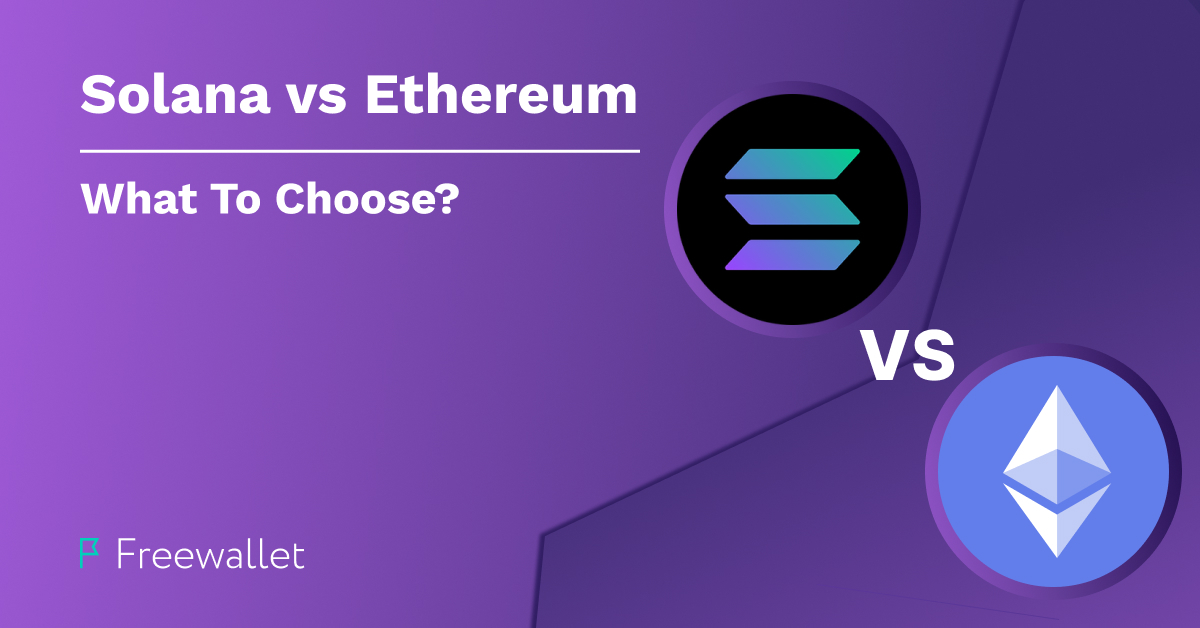
As of 2024, Solana and Ethereum are among the essential layer-1 blockchains. Both platforms serve as ecosystems for numerous cryptocurrencies, decentralized apps, and services. Ethereum was the first platform of its kind. Its success and flaws inspired other developers to create similar platforms that would be more efficient than Ethereum. In the media they are sometimes called “Ethereum killers.” However, as Ethereum steadily continues to evolve, the platform is still more popular than those that followed its steps.
Despite lacking Ethereum’s popularity, Solana has something to offer to the developers of decentralized apps (or dApps) and new cryptocurrencies and to ordinary users. Ethereum may be more secure and ubiquitous but Solana excels transaction speed and ergonomy. This article provides a complete comparison between Solana and Ethereum, highlighting both’s selling points and flaws and indicating specific demands that are better covered by Solana or Ethereum.
What is Ethereum?
Ethereum is an open-source decentralized ecosystem based on blockchain. It serves as a payment operator, virtual machine, smart contracts operator, etc. Side developers can use the Ethereum blockchain to build dApps and cryptocurrencies on top of it. Ethereum supports ERC-20 token standard facilitating and guarding the tokens built on Ethereum and ERC-721 standard used for non-fungible tokens (or NFTs).
To provide the network security, Ethereum uses a proof-of-stake consensus mechanism. The minimum solo staking amount on Ethereum is 32 ETH. This relatively high amount is aimed at reducing the number of potential violators as it makes interference attempts too costly. Transition to proof-of-stake started only in 2022. Initially, Ethereum was using a proof-of-work, consensus mechanism known for its environmental impact and excessive energy consumption.
Ethereum was created in 2013 and 2014 by Vitalik Buterin and his associates, including Gavin Wood, Charles Hoskinson, Joseph Lubin, and Anthony Di Iorio. The platform went live in 2015.
Just like Ethereum’s native crypto Ether (ETH) is the second biggest cryptocurrency after Bitcoin (BTC), Ethereum is named as the second most important invention in the history of crypto industry after Bitcoin. Ethereum dramatically changed the perception of cryptocurrencies and blockchain-based platforms in general. It introduced the concept of a blockchain-based ecosystem that allows users and developers to create their decentralized applications and currencies on top of it. These platforms and currencies rely on smart contracts and may operate without the participation of intermediaries.
This approach facilitates the Decentralized Finance (DeFi) sphere, a viable NFT market, initial coin offerings (ICOs), decentralized crypto exchanges, lending and borrowing cryptocurrencies, renting and leasing computational power for virtual machines, and many more. Ethereum stressed the potential of blockchain use in various spheres, such as supply chains, voting, healthcare data management, etc. Ethereum was instrumental in starting the movement towards web 3.0.
As Ethereum was gaining recognition, the entire crypto realm started to change. More and more blockchain-based ecosystems started to emerge, offering more efficient services than Ethereum. It is impossible to overestimate the significance of Ethereum’s impact on the crypto industry.
What is Solana?
One of the platforms that followed Ethereum is Solana. It was founded by Anatoly Yakovenko in 2017 and launched in 2020. Solana introduced a unique consensus mechanism called proof-of-history (PoH) that helped to avoid the scalability issues Ethereum is infamous for. Thanks to a unique approach, transactions on Solana are cheap and quick. More than that, the network is capable of performing more transactions in a given period of time than Ethereum. Like Ethereum, Solana is capable of hosting dApps and other cryptocurrencies. It bridges different blockchain, facilitating cross-chain transactions. The network is fueled via the Solana (SOL) token.
In proof-of-history the system creates a record of events on the Bitcoin blockchain that, paired with a verifiable delay function, validates the transaction data. The transactions make up an endless loop where the output of the previous transaction becomes an input of the next transaction so each block may contain a high amount of transactions. This feature helps to drastically increase the network’s throughput.
Another unique technology, known as Sealevel, helps to increase Solana’s capacity even further. Sealevel is a runtime capable of processing over 20,000 smart contracts simultaneously. No other platform uses technology capable of parallel running thousands of smart contracts. As of 2024, no other platform has as big capacity as Solana.
However, the advantage comes at the expense of security as some experts believe that the Solana protection level is lower than the one Bitcoin and Ethereum have.
Solana vs Ethereum (A Сomplete Сomparison)
The table below presents the main characteristics of Solana and Ethereum. The info is actual as of September 2024.
| Solana | Ethereum | Commentary | |
| Launch year | 2020 | 2015 | This characteristic is important. Ethereum had more time to establish itself in the industry and crypto market, to improve its technology, and reach out to a wider demographic. |
| Native token | Solana (SOL), ranks 5th | Ether (ETH), ranks 2nd | Ether has been the largest cryptocurrency after Bitcoin for years. Ether market cap exceeds $300 billion against Solana’s $69 billion |
| Consensus mechanism | Proof-of-history | Proof-of-stake | Solana uses a unique consensus mechanism (Yakovenko first invented PoH and it led him to create Solana). PoH radically increases the network’s throughput. However, it is not clear if PoH ends being as safe as PoS |
| Network capacity (TPS) | By different estimations, from 1,500 to 65,000 transactions per second | By different estimations, from 12 to 245 transactions per second | Transactions per second is a metric at which Solana clearly outperforms Ethereum. Without a doubt the dev team did a great job at finding the way to drastically increase the network capacity |
| Transaction fees | On average, from $0.003 to $0.03 per transaction | On average, from $1 to $1.5 per transaction | In terms of transaction costs Solana with its nearly null commissions is much more competitive than Ethereum |
| Transaction time | On average, from 5 to 20 seconds | On average, from 13 to 300 seconds | It’s understood that as Solana has better capacity, transaction time on Solana is smaller than on Ethereum. The difference is nearly 10-fold |
| Validator nodes | 2,400 nodes | 13,900 nodes | Ethereum has a much higher number of nodes and validators. It makes it considerably more secure than Solana |
| Coding language | Rust, C, C++ | Solidity | Some developers find it hard and inconvenient to write smart contracts and other software using Solidity. The languages supported by Solana may be a more attractive option |
In general, it’s safe to say that Solana is less secure than Ethereum and the SOL token is not as popular as Ether but by other factors Solana outperforms Ethereum. Time will show if proof-of-history is safe enough and if Solana is capable of replacing Ethereum from its leading position.
Conclusion
Solana is a younger project and the proof-of-history consensus mechanism serving a backbone of this network is younger than Ethereum and proof-of-stake utilized by Ethereum. Although Ethereum has more validators and can boast higher decentralization, Solana manages to keep its operations safe and stable. It’s fair to say that Solana is a strong competition for Ethereum. However, both projects keep on improving and it’s early to judge which is the best one.
FAQs
Should I invest in Solana or Ethereum?
We can’t provide investment advice. Both tokens (SOL and ETH) are the top-tier cryptocurrencies. Crypto market experts consider such assets relatively safe. However, if you want to invest in crypto, do your own research on which one to choose from Solana and Ether.
Is Solana better than Ethereum?
The Solana dev team successfully solved the issues typical for Ethereum, as Solana is quick, cheap, and is capable of operating a huge amount of transactions simultaneously. Ethereum, even after transition to proof-of-stake, is still a slow and expensive platform. However, if you see strong security is a top priority, then Ethereum may be a better alternative as Solana doesn’t have as many nodes and validators as Ethereum.
Related
Stay tuned
Subscribe for weekly updates from our blog. Promise you will not get emails any more often.
Most Popular
New Posts
Stay tuned
Subscribe for weekly updates from our blog. Promise you will not get emails any more often.




